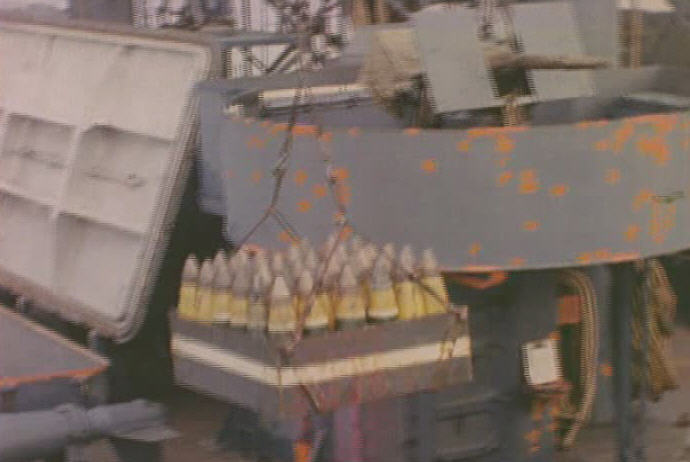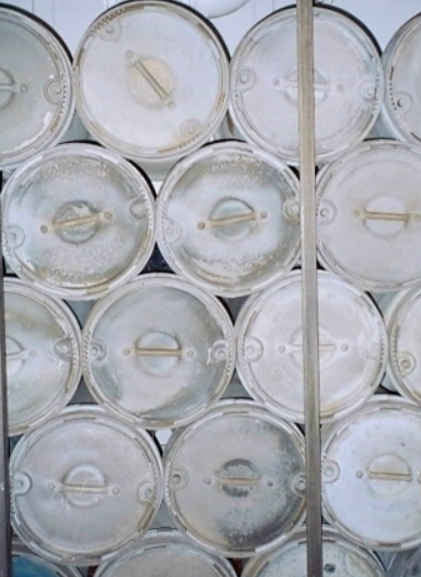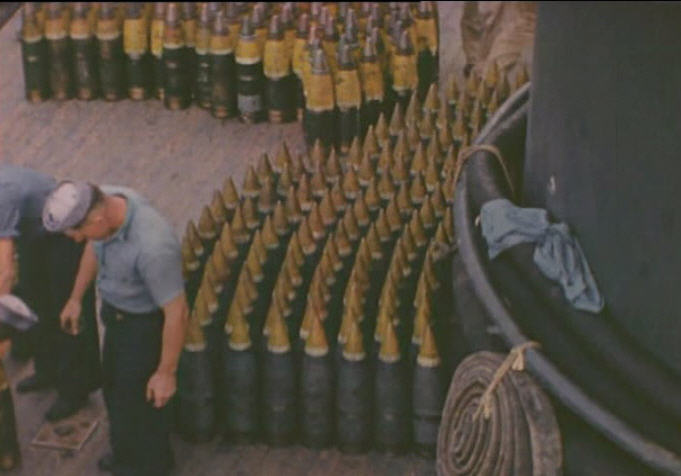
Life in a "Light Cruiser" Turret
Memories of:
Jack R. Jones, GM 3/c, 2nd Division
USS St. Louis, CL-49
In reality, we were mostly a bunch of scared kids, but when in battle, so busy and active, there was no time to think, if not scared it was because we thought ourselves to be immortal. Knowing someone was going to be hurt,................... BUT NOT ME.
Thinking back to those days.............................
Mike Bazerski the magazine Gunners Mate in charge, who by the way, noticeably paced when under attack and in touch always with the upper gun room by sound powered phones he wore when at General Quarters.
Mike would with no notice, suddenly yell POWDER !! POWDER !! NOW ! there was no talking, all sprung into movement instantly, we inside the actual powder room, opened powder cans immediately, pulled the charge out, turned to the hatch scuttle, sliding it through the powder passing scuttle to the man awaiting in the handling room, the men there, grabbed each charge immediately, and the three men waiting to load the hoist, would be ready the minute the hoist moved its cargo up to gun room, leaving an empty cradle ready to be loaded with a new charge.

The three guns would fire almost immediately, and the hoist would move up again, and three more charges inserted, this would be repeated until we got a CEASE FIRING call from the turret captain in the upper gun room (Chief White). On D-Day at Okinawa, our ship fired 400 rounds in the first hour in bombardment, started firing at 6:45 AM, stopped at 7:45 AM to allow the boats to go in, getting the beach prepared for the landings. It surely worked because the troops moved in almost a ½ mile before a shot was fired at them.
No talking sounds would be made during all this frantic movements of the men. Bazerski, would yell, CEASE FIRE !, CEASE FIRE ! we would then put back in the cans any powder cartridges we had out, put the twist top powder can lids back in place, lock them, and sink back onto the deck to relax, and cool off. Most would be sweating with no shirts on, because all air was shut off in the magazine (to keep from pulling fire into the magazine, in case of a hit ) the temperature became stifling in a very short time. This was a continually repeated thing during the firing as needed times.
No thoughts of how long, when will this be over, are we going to make it, or whatever. I at the first was shaking like I was cold during action, but one of the older guys (20, 21,22 ) told me, "Jones" you will never know if you get hit, you can’t remember going to sleep can you? And he said " what do you think about an explosion in the magazine? You wouldn’t see it or hear it. If you are going to wonder, wonder about the next watch you will be standing or what is for chow, and you will be OK. Everyone, basically had a relief valve in some manner to take care of the crisis part.
Chief White in the gun room, would call down on the horn (inter-turret audio) and try to keep us down in the magazine and projectile deck, apprised to what was going on. Turret 4 had a range finder, he could look through it and view all going on outside. If it was an air attack on our ship, and the AA guns were firing, his welcome words were often "Splashed one boogie off the port quarter" or something like that.
The ship had spread through it’s length on all decks, the crews living spaces (below the main deck), using the 4th deck, down both up forward as well as back aft on the ship, living quarters were on top of the respective powder magazines. Turret 4 & 5 were manned and maintained by the 2nd Division (we manned both turrets ) naturally our sleeping quarters were on top of the magazine for those two turrets ---- 1st, 2nd , 3rd divisions, living up forward, living quarters I presume also was on top of magazines 1, 2, 3 forward.
The magazine itself was cast of 6" armor steel entirely, top, bottom and sides like a big elongated cocoon, with the turret’s located on top of the armored barbette structure at each end. A separating bulkhead between the actual powder spaces was placed at either end of the metal cocoon inside space creating the turret #4 and turret #5 handling room where each turret’s powder hoist’s were located and gun turret’s #4 & #5 right above on the main deck.
The powder hoist had three loading chambers, like a drive in bank tellers loading station. The hoist went right up to the gun room, exited back of the 1st powder man be it right gun, center gun or left gun. The hoist was a three sided unit in the powder handling room, it was designed good, the lifts separated on its way up to the gun room to each individual gun. When the powder man in the gun room, pulled a cartridge of powder out of the hoist to drop in the loading tray of right / left / or center gun, the hoist automatically brought up the next powder cartridge, leaving an blank opening down in the powder handling room, which we kept filled.
The cartridge case of powder with its raised cork closure on the firing end was dropped in the powder tray first by the gun room powder-man, then the projectile was dropped in the tray in front of the powder, by the gun room projectile-man the cork acted as a cushion or pillow against the bottom of the projectile. Then the gun captain standing on the reverse side of the gun, watching and noting all, knew when the tray had both units in place, he then moved his "Ram" lever forward, a small "Ramming block lifted up from its closed or relaxed position at the back of the tray and rammed against the powder cartridge base, the powder cartridge was immediately shoved into the breech and of course the projectile went in first. The rim of the cartridge case sprang the breech levers forward on the firing block and the block slammed up and shut setting the gun into a firing mode.
The lights in the control booth told the turret captain the gun was loaded and ready for firing. When the gun fired the block levers were caught by the now exploded cartridge case as its rim moved back over them on the way out of the gun, this crammed the breech block back down into loading position. Tripping still another trigger that shot a bit of compressed air up through the barrel, to rid it of gases. Now all lights in the control booth would echo this happening and be turned to Red again denoting an empty gun barrel. The turret captain would know that gun had fired and was open to be loaded again. If one barrel misfired, the light would stay on "green" he knew he had a misfire on that particular gun barrel. He would notify the gunnery officer, and depending on the urgency of the moment, would be ordered to fire manually or open and eject.
The cases came out of the breech after firing, smoking and soon the gun room was filled with the smell of burnt powder and smoke. The empty cartridge case would slide back through the loading tray, out of the turret down through an ejection chute onto the deck where the damage control men, would toss them towards the water gutters by the life line to get them out of the way. They wore asbestos gloves for handling the hot brass cases.
The size of the magazines armored shell, because its weight had to be placed inside the hull while it was still open and on the ship building ways, just after the ship was laid down, #4 and #5 magazine inside area was one long area almost as wide as the ship, the 4 screw shafts from the engine rooms, ran down either side, and when running at flank speed as we did in combat, made a heck of a racket turning so fast in their bearings. Almost a scream. Real high pitched sound. We could tell when something was coming at us, the sound pitch would grow and grow, as the ship put on more turns of the screws for quicker maneuvering.
The entire large space was for stacking the powder, deck to overhead, with only enough room at the entrance hatch located at each end for two or three men to enter. One time, in the first days of the campaign, we had fired so much the magazine was almost completely empty, and one could walk the length of the magazine into the #5 handling room from the #4 side, then climb a short ladder into our 2nd Division sleeping quarters. Normally our general quarters entrance into #4 magazine was through the barbette hatch located in the mess deck area.
The "Barbette" was the round armored stack half as wide as the ship, a round circular steel tube built of 6" inch armor steel that extended from the top of the powder handling room up to the actual turret. it could be considered the "Tree Trunk" holding up the turret, on its top flange, the turret itself rode on huge roller bearings.
Inside the turret, one could drop down almost back of the center gun by a short vertical ladder onto the electric deck under the guns, on it you could work on the screw shafts the elevated each gun or work on the hydraulic motors that moved the turret in a circle left or right train, these were situated in the front part of this short area, continue down, go through a hatch, down a vertical ladder onto the upper shell deck, down through another deck hatch to the lower ammo shell deck, through another deck hatch down into the powder handling room at the bottom.
All motors were under the turret gun room. Large hydraulic motors to train and elevate the guns were located on this deck, this was called the "Electric deck. The hydraulics’ leaked all the time, from the concussion of firing, so a coffer dam was welded around and a little out from the motors on the deck to catch the leaking hydraulic fluid. We bailed it out all the time, and with a gallon size funnel, this jury rigged funnel, had an extremely fine copper mesh soldered inside it on top of the funnel portion, it looked somewhat like a gallon copper can with a funnel coming out the bottom center. We filtered the oil and poured it back in the motor reservoirs. Couldn’t have any foreign debris in the hydraulic motors. It would of taken a fuel tanker to keep the turret gun motors filled with NEW hydraulic fluid.
Our general quarters entrance armored hatch was off the mess deck, (2nd deck) as I explained, this was how normally the turret #4 magazine crew went to battle station’s. The gun room, electric deck and ammo deck crew, climbed up a ladder from the main deck and entered the gun room from underneath the back overhang of the turret. Turret 4 was a HIGH turret, as opposed to Turret 5 which one entered off the main deck, through a hatch in center back of the turret, a LOW turret.
As we depleted the powder, the empty cans were moved back to the hanger deck cavity for storage, the empty brass cases picked off the main deck after firing, were placed inside for shipping back to the states when we got someplace they could be taken off. Usually in Kerama Retto. At the opening of the Okinawa battle we were depleting our ammunition so quickly, we had to be replenished every 4 to 6 days. The barges that came to us in the anchorage, to replenish our ammo, also were off loaded with the empty cans filled with the empty casings, ( 40’s and 6" fired casings)
Each turret gun room on rapid fire could load and fire from 8 to 10 rounds a minute from each gun. (each gun room, thus were capable of firing up to 30 rounds (3 guns per turret) a minute on rapid fire), so you could get an idea of the frantic pace set where all down below were doing their job of supplying the guns with ammo. Same went on above us on the projectile (two of them) decks.
The projectiles were in racks fastened to the bulkhead. When their hoist went up, they would load from a bulkhead rack, into the hoist loading chamber a new projectile. Each of the HE projectiles (green and yellow paint) weighed 107 lbs, so they were pretty strong men. Armor piercing projectiles (black paint ) weighed 112 lbs. The armor piercing projectiles, had a sharp pointed, formed wind shield breaking nose made of a heavy gauge sheet metal or very thin metal, but it felt like sheet metal to me, this made a wind breaking mask for the rounded and blunt nose of armor piercing metal, this shield of course crumpled on contact and then, the armor piercing steel real nose plus the delayed action fuse would penetrate inside the target area and explode inside. As opposed to HE (high explosive) projectiles which blew up on immediate contact.
Normally the bridge would call for 3 or 6 rounds for spotter use, or immediate fire for effect if the co-ordinates gave us a "right on target" from the spotter , on bombarding calls or orders from the spotter on the beach. Didn’t take too much to knock out a fixed target.
Viewers of this dialog: These are the memories that rolls around in my head when I think back 69 years ago to turret #4, my work station, my battle station and my daily life aboard the cruiser St. Louis. You will now know a little more of how a turret operates and a little of the crew and maintenance life inside it when in work mode and/or firing mode.
